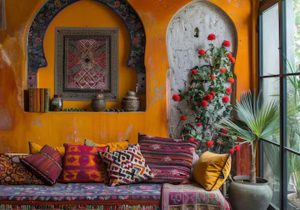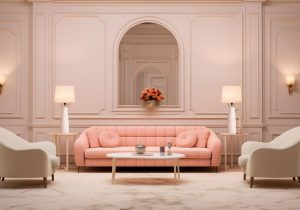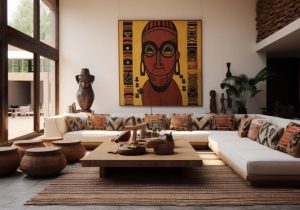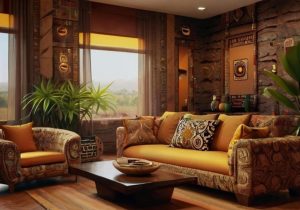India—a land whose history, culture, and tradition are as diverse as its landscapes. Be they the decorated grandeur of the palaces of Rajasthan or the simple mud houses in rural Kerala, Indian architecture and interior design have always had an attachment with the deeper cultural legacy of the country. Our ancestors have, for ages, designed not just spaces that fulfill a utilitarian need but also spaces that narrate, reflect social orders, and exalt artistic excellence.
Let’s now take a flight back into those days of the great Maharajas and Nawabs, where the art of interior design is no less than a royal affair. Say, in the cases of the fusion of Persian and Indian styles in architecture in the Mughal courts, which was a moment of inspiration for the rest of the world.
Think of the delicate jaali work—latticed screens—that adorned the palaces. In no way were they simply for decoration; they had to be exquisitely made to allow breezes to step in and cool down the rooms, while throwing beautiful patterns of light and shadow on the marble floors. The Mughals, the great patrons of extravagance and detail, made their palaces into veritable feasts for the senses, with every nook and cranny whispering tales of pure artistry.

Consider the havelis of Rajasthan, land of kings, where the affluent merchants, or Seths, lived in grandeur. These great, huge domiciles fitted the cultural roots of the wealthy owners no less than they did their wealth. The walls were done from frescoes with great detail, representing myths and daily life events, and it was always cool in the middle of the desert because of marbled floors. These havelis were no mere homes but glorified status and epicentres of cultural pride, handed down through generations.
In middle-class and rural homes, it was a different scenario. This was not to be the case for ordinary folk; they lived in houses that were highly practical and harmoniously cohabitated with the surrounding environment. In villages, for example, Kerala, traditional houses were constructed from locally available materials-laterite stone and wood, both suitable for a tropical climate. The sloping roofs of the tiles, on the other hand, were meant to bear the brunt of heavy monsoons, and the nadumuttam was the common gathering space that brought light and air into the very bowels—the core of the home. These homes stand for respect toward our ancestors who possessed wisdom in creating spaces that harmonize with nature but meet the needs of daily life.
As India moved into the modern, these traditional base elements of design did not fall through. They developed, gave way to new material, new technologies and new ways of life. Today, one gets to see the amalgamated fashion of the old and new present in Indian interior design.
Latticework from Mughal days, now reincarnated in contemporary room dividers and window treatments, or the earthy textures found in rural homes have descended upon urban apartments through the use of natural materials such as terracotta and jute. The clean lines and open spaces of modern architecture usually come poised with traditional Indian elements—be it a hand-carved wooden jharokha (window) that takes the center stage in a living room or a vibrant Madhubani painting that adds a splash of colour to an otherwise neutral palette.
The simplest and humblest of them, like the Tulsi Vrindavan in an Indian home, represents a connection to our very roots, even in the most contemporary of settings.
This blog looks into the mammoth impact India’s cultural heritage has had on interior design. We have often been looking up to how the age-old design elements have been preserved and revisited, with features that modern homes enrich and uplift. This journey will enable your aesthetics—that long to belong to your space with a whisper of tradition—or for anyone who wants to be inspired by the multifarious landscape of culture in India, this journey with us will take you closer with a deeper realization of how our heritage is shaping up the interiors today.

India’s rich cultural history has left an indelible mark on interior design, with many traditional elements finding their way into modern homes. Let’s take a closer look at some key design elements that have stood the test of time.

Europe, particularly during the Renaissance and Baroque periods, was a hotbed of artistic and architectural innovation. The design elements from these eras continue to influence interior design, especially in how we approach luxury and ornamentation.

Moving to thanese design has had a profound impact on modern interior design, particularly through its emphasis on simplicity, natural materials, and the concept of ‘Ma’—the space between objects.

African design is rich with patures, and earthy tones, drawing from the continent’s diverse cultures and landscapes. These elements have found a place in modern interiors, often adding warmth, vibrancy, and a sense of history.

The diverse geography and climate of India have thrown up numerous regional styles of architecture with their unique character. From the cool, airy courtyard houses of Kerala to the sturdy, fortified houses of Rajasthan, these regional styles have influenced how we design our homes today.
The concept of the courtyard, or angan, can be said to be an integral part of many traditional Indian homes—especially in the hot, tropical south. The open-to-sky spots were centers of a home: a place for a family to sit together, children to play, air to circulate, and interiors to remain cool.
It is getting modern interpretations in homes today, especially in urban areas where space comes at a premium. In renewed avatars, courtyards are finding their ways back into living spaces. Think small open patio in the middle of an apartment or the rooftop that turns into an urban oasis. Connected by these, one not only physically reaches from the indoors to the outdoors but also gets a feel of serenity and tranquility amidst the hustle and bustle of city life.
In the hard desert climate of the state of Rajasthan, thick-walled homes had to be made—most often of stone—with small windows for keeping out the heat. The concept was such that every home should be like a fortress against the elements: courtyards, terraces, and jharokhas or overhanging enclosed balconies provided shade and ventilation.
Although modern homes do not have to fight desert heat, some of the basic principles behind their design still apply. For instance, the indoors regulate the temperatures because of the use of natural materials like stone or clay bricks, hence restricting the use of air-conditioning. Also, shaded terraces or verandas in their design create cool, comfortable outdoor spaces that can be enjoyed even in summer.
There is an undeniable beauty in Indian interior design—something naturally melanging between past and present to create beautiful, meaningful spaces. Whether it is the intricate pattern in old traditional textiles, the vibrancy of colour from our cultural heritage, or the sane practicality of regional architecture, there is a certain something about these elements that becomes timeless.
For Bonito Designs, a house is a small, Mnemosyne reflection of your persona that tells your story and respects your roots. We retain bits of India’s glorious and rich cultural heritage in our modern design philosophy to develop spaces that are stylish, functional, warm, historical, and full of character.
Be it a dash of tradition added to the modern home, or space entirely based on cultural heritage, we at Centro take you through all that. Let the best of the past come into the present and in doing so, create a home which truly be yours.
Do this in small proportions, even with traditional textiles, handcrafted furniture, or pops of color, and add these elements in layers to your existing decor for balance.
Some popular patterns include paisleys, block prints, and floral patterns, typically incorporated on textiles such as cushions, rugs, and wall art.
Add warmth and character with bold, vivid colours—think deep reds, yellows, and blues—but in small doses so as to not overwhelm your space.
Mixing materials such as woods, stones, and textiles adds depth, texture, and dynamic interest to a space.
Bonito Designs is a personalized design solution that combines traditional Indian elements with a modern aesthetic sensibility, hence making your abode beautiful and meaningful.